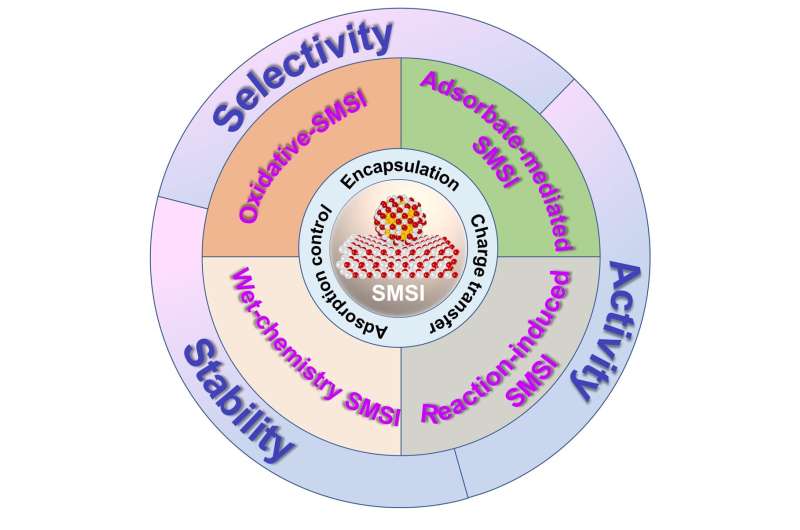Different new routes for constructing SMSIs were concluded, where the activity, selectivity, and stability of the supported metal catalysts are modified, providing an effective way for bridging thematerial synthesis and heterogeneous catalysis. Credit: Dr. Hai Wang/Science China Press
Supported metal nanoparticle (NP) catalysts play an important role in a series of industrially important reactions for fuel production, fine chemical synthesis, pollutant removal, and solar harvesting.
However, the metal NPs tend to sinter and/or leach under harsh reaction conditions causing catalyst deactivation, especially for the metals with low Tammann temperature (e.g., Au, Cu). The regeneration of the deactivated catalysts is a complex and costly process; therefore, the stabilization of the metal species against sintering and leaching is extremely important.
SMSI has been extensively used to stabilize metal NPs against sintering and/or leaching. In addition to the classical method of high temperature reduction, many new routes have been developed to construction of neotype SMSIs in recent years.
Considering the importance of SMSIs in stabilization of the supported metal nanoparticle catalyst, Wang et al. have summarized the different new strategies for constructing SMSIs. Their advantages in stabilizing metal NPs and modulating geometric/electronic structure were addressed. Furthermore, the driving force behind the formation of SMSIs were particularly discussed and the current challenges and future perspectives for the construction of neotype SMSIs were proposed.
The authors have classified the new routes for constructing SMSIs into four aspects including oxidative strong meta–support interaction (O-SMSI), adsorbate-mediated SMSI (A-SMSI), reaction-induced SMSI, and wet-chemistry SMSI (wcSMSI).
These new kinds of SMSIs have characteristics that are similar to the classical SMSI but are conceptually different because of the avoidance of high temperature reduction to induce the encapsulation of the metal nanoparticles. The SMSI formation mechanisms behind these neotype SMSIs are different, which help the development of more efficient supported metal catalysts in the future.
The authors emphasized that future work about SMSI studies might need to focus on the finely control of SMSI structure to boost the catalytic performance and use the operando characterization techniques to identify the dynamic structure of the catalysts under different atmospheres to correlate the structure-performance interplay.
Furthermore, the mechanisms behind the SMSI formation should be further investigated to guide the synthesis of more efficient supported metal catalysts.
The research was published in Science China Chemistry.
More information: Hai Wang et al, New routes for the construction of strong metal—support interactions, Science China Chemistry (2022). DOI: 10.1007/s11426-022-1356-3
Provided by Science China Press
























